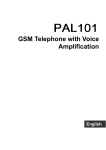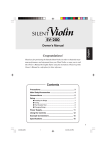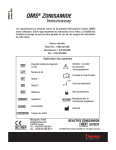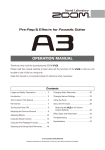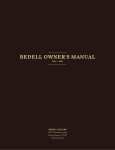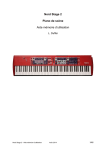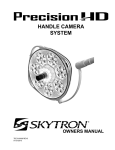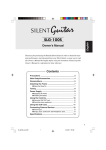Download Pioneer CT4-B Musical Instrument User Manual
Transcript
B R I N G I T T O L I F E Owners Manual www.takamine.co.uk THE ART OF INNOVATION The Takamine story started four decades ago in the town of Sakashita, Japan, with a small group of luthiers crafting modest numbers of high quality acoustic guitars following established designs and using traditional methods. Forty years on, and Takamine guitars are cherished by thousands of players the world over and championed by some of the most talented and celebrated musicians on the planet. And in this time we’ve introduced technological innovations in order to meet the needs of musicians who are themselves constantly pushing the boundaries of acoustic music. Carefully selected tone woods are stacked, turned and gently seasoned for many months in precisely controlled atmospheric conditions before use. We check guitar tops for resonance, grain and quality, while different levels of flexibility are compensated for by subtly varying the dimensions of the bracing. And whilst we’ve always held the traditional skills of the luthier in the highest esteem, we’ve never been afraid to advance the art of guitar building by embracing new technology and ideas. These guitars incorporated the first incarnation of the now legendary palathetic pickup, which set the standard for the industry. Unlike the retro-fit pickups used by other manufacturers, our pickup is an integral part of the bridge assembly, collecting both string and soundboard information. Now in its latest state-of-the-art form, it continues to be highly revered by the acoustic guitar connoisseurs. B R I N G I T T O L I F E CONTENTS Timeline 05 Takamine TLC - Care of your instrument 06 - Strings & action adjustments 08 - Troubleshooting guide 11 Pre-amps - Cool Tube and CT4-B pre-amps 12 - TK-40 and TP-4 pre-amps 16 - TRI-AX 18 Frequently asked questions 20 Servicing your Takamine 22 Owners information 22 Luthiers checklist 23 B R I N G I T T O L I F E 1962 A small family business located at the base of Takamine mountain, starts making fine, handcrafted acoustic guitars. 1968 Mr Mass Hirade joins the company heading up design and production, and shortly thereafter, introduces the first Takamine world-class ‘Classical’ guitar. 1975 The company begins overseas trading as a result of Takamine’s rapidly growing reputation. 1978 Takamine introduces its eagerly anticipated acoustic-electric guitars featuring the stunning new palathetic pickups. 1986 The first Natural Series guitar is launched and receives plaudits the world over. 1987 Takamine introduces its first Limited Edition model to celebrate 25 years of master luthiery. 1988 The Takamine Parametric EQ pre-amp is launched and immediately becomes the standard by which others are judged. 1989 Takamine develop the replaceable pre-amp package system featuring the innovative external battery box. 1994 Takamine pioneer the use of lasers to enable stunningly intricate and precise inlays. 2004 Launch of the revolutionary CoolTube pre-amp, providing the warmest amplified acoustic tones yet. 04 05 B R I N G I T T O L I F E www.takamine.co.uk THANK YOU FOR CHOOSING TAKAMINE This instrument combines materials with state-of-the-art technology to bring to the musician an unrivalled blend of innovation and craftsmanship. Please take the time to read through this manual to familiarise yourself with your new instrument. CARE OF YOUR INSTRUMENT Your guitar is finely made from select tonewoods and finished with a thin lacquer, allowing it to resonate freely when played. With careful use, your instrument will mature and give years of enjoyment. Normal wear and tear will be inevitable but to protect it from unforeseen possible harm, we recommend: ■ Taking care where you store your guitar, even when in a case. Avoid heating radiators, leaving in the sun, damp conditions etc. ■ Being aware of changes in humidity that can affect the action, volume and tone of your guitar. ■ Using a well fitting hard case for carrying and storing. ■ If travelling by air, slacken off the strings as changes in temperature and altitude can damage the top or neck if tuned to pitch. If possible take as hand luggage. ■ Keep your guitar clean, use a soft clean cloth and avoid any polish that might be slightly abrasive. Take special care with satin finishes. ■ Changing strings regularly or as soon as they loose accurate intonation. Do not allow them to become either dirty or worn, as this will cause increased fret wear. ■ If your playing style demands it, fit a pickguard to protect the surface of the top against pick or fingernail marks. Tops are usually made from selected softwoods of either Spruce or Cedar. In particular the user should be aware that Cedar tops mark easily and are widely used across the range. Please bear in mind that marks made to the guitar are not covered by any warranty. ■ It’s a good idea to Insure your guitar against accidental damage and theft when travelling and at home. 06 07 B R I N G I T T O L I F E STRINGS & ACTION ADJUSTMENTS All guitars are shipped from the factory with light/medium (.012" -.054") gauge strings on steel string guitars and normal tension nylon strings on classics. ‘Action’ is used to describe the ease of playing and the resistance felt when fretting the strings. Generally the higher off the fingerboard the strings are the higher the action setting is. The setting is measured as the distance between the top of the 12th fret to the underside of the 6th and 1st strings. However the action setting is a personal preference and can be difficult to measure accurately. Unless your guitar feels uncomfortable to play or has obvious string/fret buzz it probably does not need any adjustments. Takamine guitars are set with a standard action before they leave the factory and small adjustments are also be made to the truss rod, saddle and nut at quality control in the Korg U.K warehouse. This is to correct any movement that may have occurred during shipping. This extra care ensures that your guitar is in a fine playable condition that suits the requirements of most guitarists and retains optimum volume and tone. www.takamine.co.uk When changing strings, do not wind on too many turns, 3 or 4 is usually sufficient with wound strings and 4 to 5 turns on plain. Too many string windings can cause tuning stability problems. If you are changing to a different gauge of string it may be necessary to adjust the truss rod to balance the change in stress on the neck to restore the previous action setting. Strings that seem uncomfortably higher or have significant string buzz in a particular area of the fretboard indicate an adjustment may be needed. All Japanese made Takamine guitars are built with an adjustable bi-flex truss rod. This counter-balances string tension and permits adjustment of neck straightness to compensate for changes due to humidity conditions or strings. The truss rod adjusting nut is located below the fingerboard, just inside the sound hole. It is adjusted to remove too much relief (forward bow), which may be needed when changing to heavier gauge strings and adjusted when relief is required (backward bow) i.e. perhaps when changing to lighter gauge strings. Adjustment must be made carefully, preferably whilst the strings are tuned to desired pitch so that you can see the affect adjustment is making and try the result (slacken off the third and fourth strings to gain access without damaging the strings). The bone nut, tuning machines and stringing 08 09 B R I N G I T T O The truss rod adjusting nut Clockwise (green arrow) rotation corrects forward bow. Anti-clockwise (yellow arrow) rotation for correcting back bow. Note: 5mm Allen key required for adjustment (not supplied) IMPORTANT Never make forced adjustments especially if the nut will not easily rotate. It is possible to over adjust the truss rod and cause irrepairable damage to your guitar. If you are uncertain about making any adjustments please ask your authorised Takamine retailer or a reputable guitar technician. Once the neck is in the correct setting, further adjustments to lower action can only be made at the saddle and the nut. This is done by removal of material from the saddle and then nut string slots, in that order, if necessary. Care must be taken, as the action cannot be properly raised afterwards without replacing either of these integral parts. Again, an authorised retailer or guitar technician should be able to make adjustments. Takamine do not guarantee guitars against string or fret buzz because the action is set too low. If you wish to have a very low action set on your guitar this can usually be done but may be chargeable. Extreme Forward Bow 10 www.takamine.co.uk L I F E TROUBLESHOOTING GUIDE PROBLEM LOOK AT Resonant buzz on certain notes Action/Truss rod setting (adjustments required) Strings (buckled or poor quality) Frets for wear (repair work required) Poor intonation Strings (replace worn or corroded) Truss rod setting (tighten if neck has excessive convex bow) Action setting altered Truss rod setting (tighten for when strings changed heavier strings and loosen for lighter) Distortion when plugged in Battery (replace with alkaline type) Extreme Back Bow 11 B R I N G I T T O L I F E CT4-B PRE-AMP Your guitar may be fitted with any of the following pre-amps. Please refer to the separate pre-amp information for operation and specifications. CT-4B pre-amp features ■ The CT4B pre-amp is designed for ease of use and purity of tone. The CT4B consists of 3 bands of graphic EQ tone control, a volume control slider and a built-in chromatic tuner. ■ The 3 band EQ provides control over the bass (LOW), midrange (MID) and treble (HIGH) frequency response. With the sliders set at the midpoint (0) the electric signal from the guitar is evenly balanced across the frequency range. The desired tone is then dialed in by using the sliders to add or subtract frequency response as desired. Each frequency control slider will raise or lower the band response by +/-5db. ■ The volume slider adjusts the output volume of the pre-amp. ■ The convenient built-in chromatic tuner is extremely accurate and very easy to use. The tuner is activated by pressing the TUNER POWER button. To tune your instrument, simply pluck any open string. The tuner will then display the name of the note that has the closest frequency of the string played. The amount of deviation from the note (higher or lower) is displayed by red arrows indicating sharp or flat. When only the green center light illuminates, the note indicated in red has reached precise tuning. When the guitar is unplugged, the TUNER POWER switch acts as on and off. Your CT4B tuner is also capable of being calibrated to frequencies other than standard A440. When the PITCH button is pressed, the frequency that is currently set will be shown by a flashing red light above the frequency number. While the reference light is flashing, press the Pitch repeatedly to set the desired reference pitch. With each press of the button, the reference pitch will increase by 1Hz increments from 440Hz to 445Hz. Once the pitch has reached 445Hz, the next press will decrease the pitch to 438Hz. When the button operation is stopped, the reference pitch is set and the tuner will stand by for tuning. 12 13 B R I N G I T T O www.takamine.co.uk L I F E The CTP-1 ‘Cool Tube’ pre-amp gets its name from Takamine’s unique and new technology that runs the Tube at very low voltages, therefore the tube does not glow or produce high levels of heat. The tube actually runs at only two or three degrees above ambient, so there is no concern over the delicate tone woods being affected by radiant heat. With the Takamine CTP-1 ‘Cool Tube’ pre-amp, the playing will be hot, the tone will be warm, and the tube always remains cool. Cool Tube Features CTP-1 ‘COOL TUBE’ PRE-AMP To facilitate silent on-stage tuning, the TUNER POWER button also acts as a mute switch when the guitar is played amplified. If you wish to be able to tune with your signal amplified, simply press the TUNER POWER a second time. Press a third time to shut off the tuner function. The tuner will shut off automatically when there is no signal for a couple of minutes. The CTP-1 ‘Cool Tube’ pre-amp The Takamine CTP-1 ‘Cool Tube’ pre-amp is an on-board acousticelectric pre-amp that utilizes a 12AU7 dual triode vacuum tube. The CTP-1 packs a huge amount of features and amazing tone into a compact package that fits neatly into Takamine’s ‘Sound Choice’ docking port. 14 Takamine players will find a most useful array of features to enhance their recording or live performance applications: ■ A chromatic tuner available at your fingertips keeps the guitar in tune. The tuner is capable of being calibrated from A438, to A445. An LED display reveals the note being played and directs the player with illuminated arrows that show sharp and flat. ■ The EQ section utilizes a shelving, graphic EQ, which can cut or boost bass and treble frequencies. The mid range is shaped using a semi-parametric EQ section comprised of a rotary knob used to choose the mid point of the midrange frequency. The midrange frequency can be cut or boosted with the mid slider. The range of frequency covered by the rotary knob is 200hz to 8.5Khz. ■ The tonality of the pre-amp is further enhanced by the use of the rotary knob labelled ‘Cool Tube’. With this control, the player chooses the depth of effect the tube places on the signal generated by the proven Takamine ‘Palathetic’ pickup. With this knob the player can choose from a high degree of ‘CUT’ for aggressive strumming; expanded ‘sweetness’ and harmonic density with fatter lows and rounder highs; or levels of rewarding richness for finger style players. ■ An auxiliary input jack and volume knob, which can control an additional add-on pickup of your choice. This facility can accept a magnetic sound hole pickup, or a soundboard transducer. The AUX control knob is used to blend the add-on signal with the Takamine pickup. A small switch in the back of the pre-amp can be used to match the varying outputs of different pickups with the pre-amp. The output volume slider can then control the blended signal. The CTP-1 is powered by 4 AA batteries, which will deliver approximately 24 hours of playing time. 15 B R I N G I T T O L I F E www.takamine.co.uk TAKAMINE TK-40 AND TP-4 Our Takamine G Series electro-acoustic guitars come equipped with either the TK-40 or TP-4 pre-amps, each of which has been designed to provide exceptional naturalness of amplified tone and maximum ease of use. Both pre-amps feature gain, bass, mid and treble controls plus a low battery indicator, while the TK-40 offers players the added benefits of a highly accurate built-in tuner, EQ bypass, notch filter and a mid contour switch. The following provides a quick overview of the pre-amps’ functions. Gain. The gain control regulates the output level of the amplified signal. Before plugging in, it’s generally a good idea to set the gain control to ‘min’ and then gradually advance it clockwise until you find the ideal level. Three band EQ (bass, mid and treble). The EQ controls are active, so they can cut and boost levels within their respective ranges, allowing you to precisely control your tone and adjust it to suit your taste and playing environment. With the sliders in the middle positions, or ‘0’, the tone is unaffected and is a good place from which to start modifying your sound. Low Bat. Following the insertion of a jack plug into your guitar, the red battery LED will illuminate for approximately one second showing that the pre-amp has been activated. If the LED glows dimly, this indicates that the battery level is low and due for a change. 16 Additional features of the TK-40 pre-amp: EQ Bypass. Bypassing EQ is desirable in some studio or live environments where external EQ is preferable. It’s also useful in that it allows you to compare your EQ adjustments to your unaffected amplified tone. With the switch in the depressed position, the EQ is active - return it to the ‘up’ position and the EQ is bypassed. Notch Filter. The notch filter is a highly selective form of EQ that affects only an extremely narrow and deep cut of an audio frequency band. The TK-40 has a tuneable notch filter, allowing you to select the frequencies affected by the notch so you can dial out feedback. If monitor or stage levels are too high and you hear your guitar starting to feed back, press notch filter in/out and simply tune out the feedback by slowly rotating the rotary notch control until it’s eliminated. Mid Contour. Press the mid contour button and you activate a pre-shaped EQ that emphasises the frequencies that best complement an amplified acoustic guitar. The control can add punch or reduce unwanted mid frequencies. Try experimenting with the mid contour and the ‘Mid’ EQ control to find the tonality that suits you best. Tuner. The tuner in the TK-40 is fully chromatic and automatic. Simply press the tuner switch to activate it, sound each string in turn, tune to concert pitch and then start playing! 17 B R I N G I T T O L I F E www.takamine.co.uk TRI-AX We developed the Takamine TRI-AX with acoustic amplification specialists Lloyd Baggs to produce a truly great sounding soundhole-mounted unit and one that complements the CTP-1 Cool Tube pre-amp perfectly. It’s ability to produce breathtakingly realistic acoustic tones is largely down to the unique Tri-Axial Dynamic body sensor, which not only captures the information generated by string vibration, but also the complex vibration of the guitar’s top. And the smooth, fingernail-friendly pole pieces are fully adjustable to ensure a flawless balanced output. The humbucking nature of the pickup’s design together with the built-in Class A pre-amp, make for superb noiseless performance whether in the studio or on stage. 18 It’s also highly resistant to acoustic feedback, which of course, is just what you need for playing live. You can choose to run the TRI-AX in either active or passive modes. When connected to the Cool-Tube, select passive mode and use the Cool-Tube’s Aux control to blend with the Palathetic pickup for a greatly expanded palette of rich tonal possibilities. In active mode, and with the onboard volume control in circuit, the TRI-AX delivers a strong, noiseless signal for driving an amp or mixing desk. The TRI-AX comes complete with a cable to end pin jack connection, plus a cable allowing you to connect it directly to the Aux input of the Cool-Tube. The TRI-AX is powered by an easy-access CR2032 3-volt lithium coin cell providing around 1,000 hours of use. 15 19 B R I N G I T T O L I F E www.takamine.co.uk FREQUENTLY ASKED QUESTIONS Q. What strings do Takamine use? A. Takamine use their own brand strings and D’Addario EXP strings. The gauge for steel strings is .012" to .054". Nylon strings are normal tension. Q. I think the neck might need adjustment, should I adjust the truss rod myself? A. You probably can if you are careful. A quarter of a turn may be all that is needed. Remember the adjustment you are making so that you can reset it to the original position if needed. Be sure not to overtighten the rod, if it feels tight seek advice. Q. I would like to fit a strap button rather than tie the strap at the nut. Where is the best position to fit it and what is your advice? A. Most guitar repairers will supply a button and do this job for you. It’s a small job but requires a lot of care in positioning the button and fitting it. Probably the best position is a location on the heel taking into account the curvature of the neck, how it balances the guitar, affects on playing the higher position frets and fitting the guitar into a case. Q. Can I take my guitar abroad? A. Yes. Takamine guitars are sold all over the world. Just bear in mind that changes in humidity will almost certainly affect the action/neck settings once adapted to the new environment. Adjustments may be needed. Avoid the jungle! 20 Q. I think my guitar needs a service, any suggestions? A. There are plenty of very competent guitar makers around and it would be best to take it with you to demonstrate problems. Try the shop where you purchased it first though, as they might be able to help. Be aware of the length and conditions of the warranty. Q. I have noticed some small playing marks appearing on the front of my guitar. Should playing marks appear so easily? I am not a heavy player. A. Unfortunately it is fairly easy to mark softwoods such as Cedar. Marks caused by picks or fingernails are quite commonplace unless a pickguard is fitted. Q. It seems that the sound of my guitar has changed from when I bought it, is this possible? A. Hopefully the sound will have improved as the woods age. If the sound of your guitar has deteriated then it could be due to old, damaged or poor quality strings, fretwear or wear to the saddle or nut. It is recommended you seek help if changing the strings doesn't fix it. 21 B R I N G I T T O www.takamine.co.uk L I F E SERVICING YOUR TAKAMINE LUTHIER’S CHECKLIST Please make sure you keep your purchase receipt. In the U.K your guarantee is for one year from the date of purchase. This covers you against faulty workmanship and materials but not normal wear and tear or misuse. Should your Takamine guitar develop a problem and require attention and is still under guarantee you should contact your authorised retailer who will be able to help. Each and every guitar that passes through our warehouse is individually checked by qualified luthiers to ensure they meet the highest standards. OWNERS INFORMATION Model: Serial No: Each of the following points are addressed: ■ Truss Rod and neck angle ■ Cosmetic Approval ■ Fret edges and stability ■ Pre-amp check ■ Intonation ■ Action Purchased from: Date: Other information: This owners manual is produced by Korg U.K. It is for general guidance only. No liability is accepted for misuse or misinterpretation of its content. Takamine may change or upgrade model specifications. 22 23













